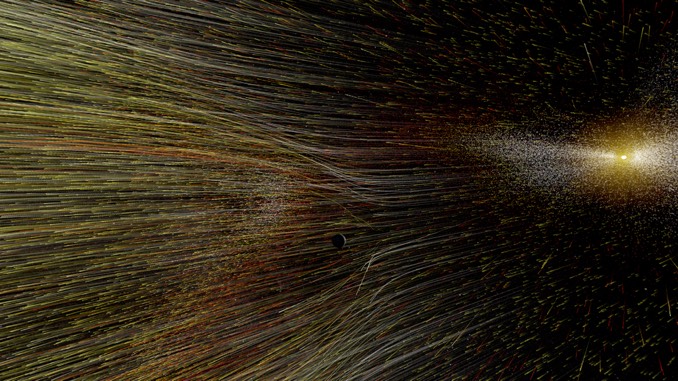
The European Space Agency is pressing ahead with the Comet Interceptor mission, a three-spacecraft ensemble intended to study a pristine comet or other body making its first trip into the inner solar system. NASA, meanwhile, has selected two new missions to study how the solar wind is generated and how it interacts with Earth’s magnetic field.
The $165 million Polarimeter to Unify the Corona and Heliosphere, or PUNCH, will consist of four suitcase-size “microsat” spacecraft that will be launched into Earth orbit as early as 2022. The four spacecraft will study the Sun’s outer atmosphere, or corona, and how it “infuses” the solar wind with electrically charged particles that stream away in all directions.
“The vacuum of space between the planets is not completely empty — it is actually filled with a tenuous, hypersonic ‘solar wind’ that streams out from the corona and affects spacecraft and planets — including our own,” said PUNCH Principal Investigator Craig DeForest, director of the Southwest Research Institute’s Space Science and Engineering Division. “PUNCH will observe the no-man’s land between the outer solar corona and the solar wind, giving us our first clear images of the entire system connecting the Sun and Earth.”
The second NASA mission, the twin Tandem Reconnection and Cusp Electrodynamics Reconnaissance Satellites, or TRACERS, will be launched as secondary payloads with PUNCH. The two TRACERS satellites, cost capped at $115 million, will focus on Earth’s north magnetic “cusp” region where field lines arc down toward the pole, guiding charged solar wind particles into the planet’s atmosphere.

NASA also has selected three finalists for a future small satellite contract.
The proposed Janus mission would study the formation and evolution of small “rubble-pile” binary asteroids. The Escape and Plasma Acceleration and Dynamics Explorers, or EscaPADE, mission would study how the atmosphere of Mars is stripped away and how it interacts with the solar wind. The third proposal, known as Lunar Trailblazer, would directly map water on the Moon, including ice deposits in permanently shadowed craters.
“Each of these concepts holds the promise to deliver big science in a small package,” said Thomas Zurbuchen, associate administrator for science at NASA Headquarters. “Their miniaturised size enables these systems to be developed at reduced overall costs while performing targeted science missions and testing brand new technologies that future missions can use.”
ESA’s Comet Interceptor is a so-called “fast-class” mission under the European Space Agency’s Cosmic Vision Programme. Targeted for launch in 2028 to the Sun-Earth Lagrange point L2, the Comet Interceptor will hold station until a suitable target is identified. The three spacecraft then will carry out simultaneous observations from multiple vantage points to create what amounts to a 3D profile.
Current planning calls for launch in 2028 with ESA’s exoplanet-hunting ARIEL spacecraft.
“Pristine or dynamically new comets are entirely uncharted and make compelling targets for close-range spacecraft exploration to better understand the diversity and evolution of comets,” said Günther Hasinger, ESA’s Director of Science.
“The huge scientific achievements of Giotto and Rosetta – our legacy missions to comets – are unrivalled, but now it is time to build upon their successes and visit a pristine comet, or be ready for the next ‘Oumuamua-like interstellar object.”



